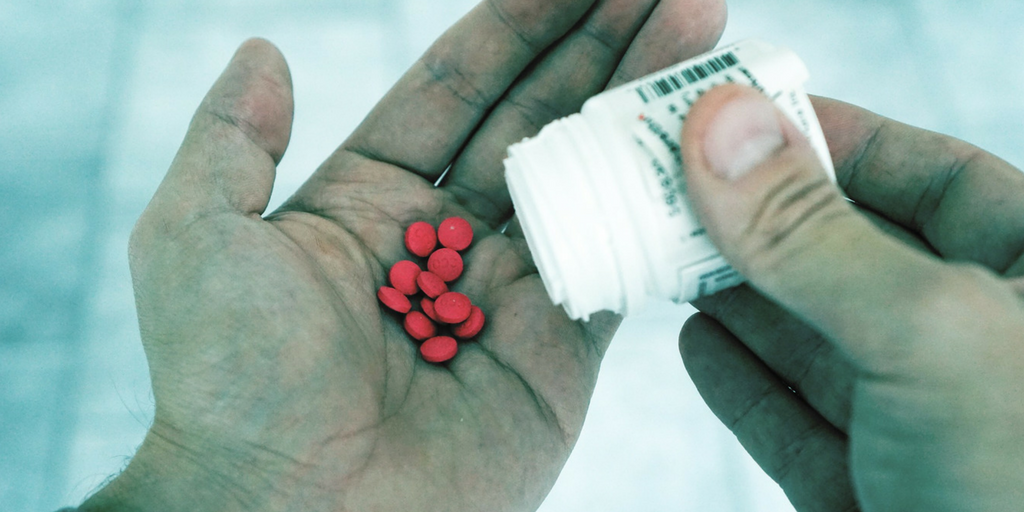What Causes Ankylosing Spondylitis (And How to Stop It Naturally)


For those diagnosed with an autoimmune disease such ankylosing spondylitis, the picture painted is oftentimes grim.
A rigid spine, limited mobility, and debilitating pain are just some of the complications associated with this condition.
To make matters worse, it’s likely you’ve been told medication was the only answer and the rest is out of your control.
We’re here to paint a different picture for you.
Managing an autoimmune disease is similar to that of a game of chess – staying one step ahead is the key to success.
And how exactly do you stay one step ahead?
Identifying the triggers (like diet and stress) and knowing how to control them is the name of the game.
Despite popular belief, autoimmune diseases like ankylosing spondylitis need to be turned on or activated… and you’ll be happy to know we play a huge role in whether those triggers are turned on or off.
Read on, as we dive into the details of autoimmunity, bring you the latest research, and help you discover the necessary tools to get your health back.
What is Ankylosing Spondylitis?
Ankylosing spondylitis (AS) is a type of arthritis in which chronic inflammation targets the pelvis and spine. This long standing inflammation causes pain that often starts in the lower back and works it’s way up into the spine.
Eventually, the vertebrae (bones of the spine) can fuse together, causing the spine to become rigid and inflexible. This condition is a systemic disease, which means those affected may also experience a fever, appetite loss and overall fatigue. Inflammation of the eyes (iritis) occurs in up to 40% of ankylosing spondylitis cases.
A patient’s medical history, a thorough joint examination and blood tests are often used to diagnose this condition, which is more likely to affect men between the ages of 17 and 35.
Perhaps one of the most confirming findings in the diagnosis of AS is the presence of the HLS – B27 gene, as research shows it is present in 80-95% of cases worldwide.
Having this gene doesn’t necessarily mean you’ll develop AS, though. Researchers estimate that 8 in every 100 people in the general population have the HLA-B27 gene, but most don’t present with AS.
So why are some able to escape the manifestations of ankylosing spondylitis?
Ankylosing Spondylitis Triggers

The one commonality between nearly every autoimmune condition is the fact that certain genes are present, and this increases susceptibility to the disease.
What researchers are discovering, though, is that environmental triggers hold the power to turn these genes on or off. This research article solidifies the fact that genetic factors alone aren’t responsible for the expression of AS and autoimmune conditions in general.
So, what are some of the factors that can help turn the progression of AS “on”?
Bacterial Infection – The most well-known and well-studied is Klebsiella pneumonia – a bacterial infection of the gut. In those with the HLA-B27 gene marker, antibodies set to kill the infection cross-react and it is suggested that ankylosing spondylitis may occur as a result of immunological and inflammatory damage following infection. Inflammation can lead to the release of chemicals that can harm surrounding tissue, causing scar tissue to build up. In AS, scar tissue can harden and allow the bones to fuse together and ultimately cause pain and restrict movement.
Studies indicate that Klebsiella can be isolated in faecal cultures obtained from AS patients and this relationship increases the need for further long-term studies. Other bacterial infections, such as Enterobacter, Salmonella, Shigella, Mycobacterial & Yersinia, are also thought to play a role in triggering AS.
Physical and Emotional Stress – An objective study of 1,080 AS patients showed 5% reported heavy physical activity in the 3 months prior to the onset of symptoms, 4.2% experienced emotional stressors and 3.1% experienced work stressors. Pregnancy was reported by 7.4% of the female participants. Stress is known to ramp up the immune system and can trigger it to go into overdrive.
Diet – Many AS sufferers self-report dramatic improvement while on a dairy-free diet – even to the point where they were able to discontinue the use of NSAID medications. The connection is thought to be because the milk sugar lactose feeds unhealthy bacteria in the gut, leading to further inflammation and possible infections of the gut.
The intake of dietary starch and it’s its role in the development of ankylosing spondylitis has been well studied. Researchers found up to 20% of starch from a test meal was able to escape the small intestine and reach the large intestine, where it can then provide fuel for over 400 different types of colonic bacteria.
These findings help explain why the presence of faecal Klebsiella p. concentrations in those with a high starch diet were 40 times higher than those consuming a low carbohydrate/high protein diet. Studies of Klebsiella p. have shown that this bacteria does not feed on cellulose derived from plants but can grow readily on more simple sugars. Most simple sugars, like glucose, are absorbed in the proximal small intestine and are therefore unavailable to Klebsiella.
It’s no surprise the common theme among the triggers listed above is the gut.
If you feel a little confused or surprised by the concept that the spine and the gut are connected, we don’t blame you. It certainly isn’t natural to connect those dots, but it’s really important that we do.
The Leaky Gut Connection to Ankylosing Spondylitis
Understanding the gut microbiome is imperative to nearly every health condition on the planet and researchers have been able to firmly establish the correlation between AS and gut issues.
The term leaky gut means the gut is inflamed and the cells are starting to break down, letting larger food molecules through. This creates an immune response, as the body tries to get rid of this foreign molecule in the bloodstream.
It also means dysbiosis is most likely present, which is an imbalance of bacteria in the gut (too much of the bad, not enough of the good.)
In the presence of a leaky gut, the body produces an immune response (antibodies) to fight these foreign antigens, but the antibodies are thought to also cross-react with antigens in the joint tissues.
In other words, the antibodies formed to attack the molecule (that shouldn’t be there) can cross-react and “accidentally” bind to HLA-B27. The types of cross-reactive antibodies produced following Klebsiella infections can attack types I, III, and IV collagen, which is an important part of the spinal tissue.
This idea of antibodies binding to “self” is characteristic of autoimmunity.
The result is an inflammatory cascade that produces the cytokines involved in the formation of new bone… leading to the development of classical AS symptoms.
The fact that gut health plays a role in autoimmune diseases, such as rheumatoid arthritis, psoriasis and AS, is well established and helps explain why between 5% and 10% of patients with AS develop inflammatory bowel disease (IBD) and 70% develop subclinical gut inflammation.
“An association between inflammatory bowel disease, enteroarthritis and the spondyloarthropathies has been known for a while… and it now seems evident that chronic gut inflammation is either associated with or is even the cause of chronicity of peripheral arthritis and the development of ankylosing spondylitis.” ~ Finnish Rheumatology researcher Marjatta Leirisalo-Repo
The ability to treat and maintain AS with a natural approach devoid of harsh medications depends largely upon knowledge and research of the gut, as well as addressing potential issues.
Current Treatment Options – A Vicious Cycle?

The main goals of treating ankylosing spondylitis is to reduce pain and stiffness and to improve or maintain functional capabilities.
Non-steroidal anti-inflammatory drugs (NSAIDs), like aspirin and Ibuprofen remain the cornerstone in the treatment of AS.
But what happens when the medical solution is part of the problem?
A lot of attention has been given to the role NSAIDs play in gut health and researchers show the chronic use of these medications increases intestinal permeability.
The vicious cycle looks something like this:
Disease -> NSAIDs to combat inflammation -> Increased intestinal permeability because of NSAIDs -> More Inflammation -> Increased Dose of NSAIDs
The amount of research dedicated to this correlation is overwhelming and helps explain why these medications become a lifelong commitment.
- This study showed that just one 600 mg dose of Aspirin was enough to increase intestinal permeability
- Four and nine patients (of 13) developed inflammation after three and six months treatment with NSAIDs, respectively.
- This study shows how NSAIDs affect the gut flora, which we now know to be extremely important in overall health.
Attacking the root of why the inflammation is occurring in the first place would decrease the need for such heavy, long-term use of NSAIDs.
There is a time and place for the use of anti-inflammatory medications, but solely relying on them for the treatment of AS can create a vicious cycle that is extremely hard to get out of.
So, How Can I Treat Ankylosing Spondylitis?
Until recently, we used to think autoimmunity couldn’t be “turned off” once it was “turned on.”
However, the latest research is changing those thoughts.
Researcher Alessio Fasano, M.D. has been on the forefront of recent autoimmune disease research and published a paper titled “Leaky Gut and Autoimmune Diseases.”
His findings present a new theory that the prevention and reversal of autoimmune disease is possible. Fasano presents the idea that in order for an autoimmune condition to develop, 3 pre-existing conditions must all exist together.
- A genetic predisposition to autoimmunity (In ankylosing spondylitis, this is HLA – B27)
- An exposure to the environmental trigger (i.e. food, infection, stress)
- Increased intestinal permeability (a.k.a. Leaky Gut Syndrome)
Fasano’s theory begins to open the idea that, if we start in the gut, we may be able to reverse autoimmune disease.
How to Turn Off Autoimmune Disease

All autoimmune conditions have one thing in common – an overactive immune system that must be triggered.
Research has helped us to identify and understand these triggers and now it’s up to us to address them.
Based on the work of Dr. Alessio Fasano, one of the first places to start is your gut… and we’re here to help you.
We hosted a free webinar called, “How to Turn Off Your Autoimmunity and Restore a Healthy Immune System.”
It’s completely free, and we walk you through how to address the health of your gut so that your immune system can stop attacking itself.
The topic of autoimmunity is complicated and the amount of information out there can be overwhelming. That’s why we’ve done the work for you and are grateful to support you on this journey.
-Steve
Did You Like this Article?
Subscribe to our newsletter to receive email notifications, some ways to find relief, and next steps.
